List of Authors
>>About this blog
Recent blog post
|
[Shiba Inu]
October 29, 2016 12:00
The annual Autumn Ginza has reached the middle stage.
Autumn Ginza is a big event where famous shops participate from Ginza 1-chome to 8-chome. This name was given in 2010, but before that it was held under the name "Promenade Ginza". There are lots of fun events this year, but did you participate in the silver tea ceremony? Until November 3, there will be still many great and wonderful events, so please come and visit us in the future. Time schedules are available from the website!
Meanwhile, there are events that are receiving hot support from some people every year. That's it
"Ginza Hatcho Shrine Tour"!
We collect vermilion seal stamp stamps around designated shrines in Ginza. Once you've collected everything, you can get a souvenir. Here's the souvenir
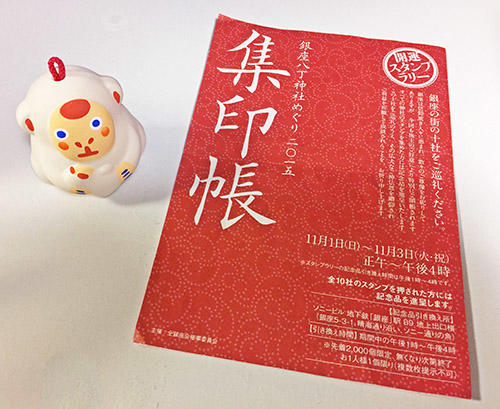 It's the zodiac bell of next year! It's the zodiac bell of next year!
It's cute!
It feels like this when you open it inside the red seal book.
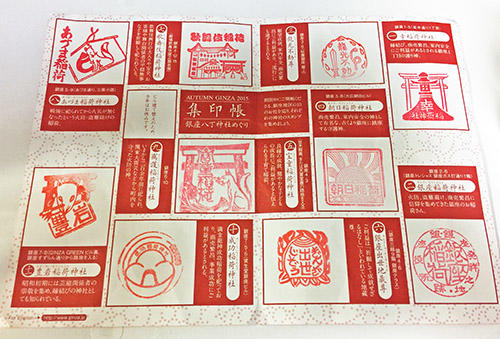 This is also cute. This is also cute.
(Both images are from last year.)
The souvenirs that can be given at each shrine are also unique and fun and memorable. The most enjoyable thing is to look for a shrine and walk. Because it is a shrine in Ginza, it's not big. Or, if you don't find it, you can't find it. There is also a shrine called "No way!" It is a shrine of history that has been close to the area for many years in one of the world's largest cities. No matter which shrine you go to, it has excitement and fun. And since it's Hatcho Shrine, you can go around Ginza when you go around everything. It's about two hours if you take a leisurely walk. It's easy to walk, so I think it's a reasonable walking course.
From 11/1 to 3. Please come by all means.
Click here for more information about Ginza Hatcho Shrine! http://www.ginza.jp/topics/6288
[O'age]
October 27, 2016 09:00
Site of Sadakichi Chiba Dojo
The trace of the dojo of the younger brother of Shusaku Chiba, the founder of the Hokushin Ichito style.
The description of this explanation board (Chuo-ku Board of Education) is not in the text, but the theme of the 9th Chuo-ku Tourism Certification is the Kyobashi area. It is located on the southern sidewalk of Kajibashi Street (2-8 Yaesu).
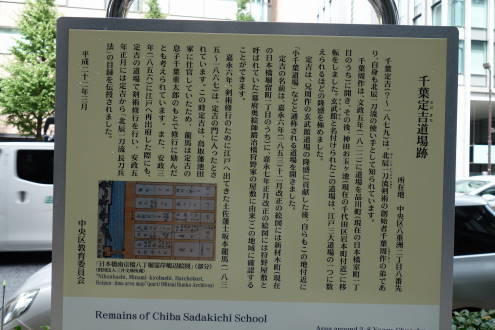
In addition, monuments with photographs and illustrations, such as the history of Kyobashi near the same sidewalk, may this be an object that cannot be overlooked when walking around the city? (It is not from the Board of Education)
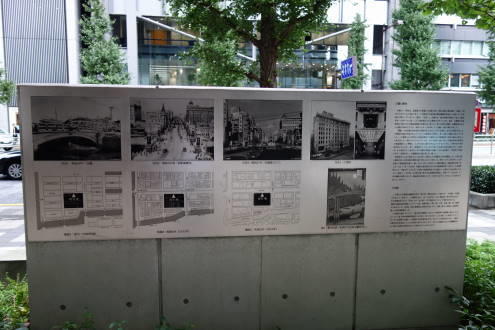
[CAM]
October 25, 2016 16:00
The definition of "Edokko" is famous by Kyoden Santo (1761-1816), and is quoted in "Monoshiri Encyclopedia" (page 79, published in 2016). The original text of this "Community Somagaki" is as follows (Iwanami Shoten, Vol. 59 of the Nihon Classical Literature, Vol. 59, "Yellow Spinning Books", published in 1958).
>Looking at the golden fish tiger (Shachihoko), bathe the tap water in a hot spring, grow up at the knee, eat rice of Ogamizuki, and nanny parasol (Onba Hikarakasa) In the long (person), gold and silver Sasago Hajiki, and Mutsuyama (Michinokuyama). The water of the corner is also in the middle of the water, and the Daimon hits the corner mansion in Honmachi. From the root bone of Edokko (Kojiya Bone), the middle of the Japanese chopsticks that spans all things, if you look at it, you will be able to enter the Shinkaze and the new road of Isecho (Isete), enter the service population, and enter the public population. (Kanban) Supumukofu, black lattice, orran is always planted.
When I first read this, I caught my eyes on the part of "bathing tap water in hot water", and I was a little strange wonder why "water supply" became a requirement of "Edo kid". Regarding the situation around this area, Kafu Nagai wrote an essay called "Water of Well" (October 1876), and if you read this, you can understand the background well.
>The water supply was called clean water in the Edo period, and it is a place for people to know that it was opened far away in the Meiryaku era. It is not surprising that there were two streams of Kanda and Senkawa in addition to Tamagawa in water supply. When I was a child, people around Otowa and Kohinata remember using Kanda Josui from the Edo period as it is. At the same time, in order to use the water supply at that time, he dug a well into a gutter where the water supply flowed, and pumped water in a bell tub attached to the tip of a bamboo pole.
Once upon a time in Edo, Josui had only flowed through the busy towns of Kyobashi, Ryogoku, and Kanda, and on the remote mountainside, even in places where it was in the passages of Josui, near Yotsuya and Sekiguchi, could not use it in a flood. Therefore, if you say that you are a man who uses hot water from tap water, you will be born in the busiest downtown area in Edo, and if you are not Kanda Myojin, you will be Sanno's shrine parishioner, so it is a place where you are proud of Edo Tsuko. (A long time ago, it was said that those who lived around Koishikawa, Ushigome, and around Akasaka Azabu will go to Edo when they go to downtown. ) (17-32)
If you read this, at the beginning of the Meiji era, you can see that those who lived around Koishikawa, Ushigome, and Akasaka Azabu said that they would go to Edo when they went to downtown.
[Slow of Satsuki's Koi]
October 21, 2016 16:00
Continuing from Edo's specialty, "Inari no Dog droppings"
First, "dog droppings"
It seems that there were many people who kept pets in the Edo period.
It seems that 20 dogs are depicted in "Kidai Shoran".
(I don't count) Also in the diary of a lower class samurai
It seems that there was also a saying, "I felt uncomfortable by stepping on the dog's droppings."
Finally "Inari"
I don't notice, but there are Inari in some places.
It is located on the side of the seaside seafood bridge at Tsukiji Fish Bank.
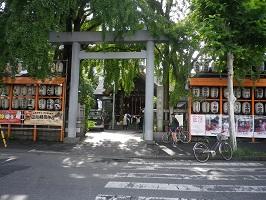
The front side of Kabuki Inari Kabukiza Theater
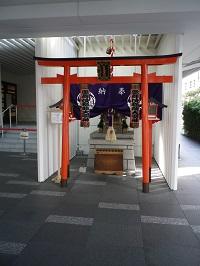
Azuma Inari Ginza Miharakoji

It was introduced on NHK Bra Tamori "Ginza" behind Asahi Inari Ginza Matsuya
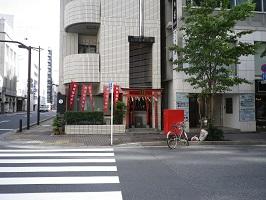 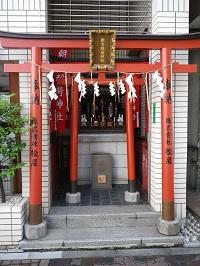
It's near the Hoju Inari Kabukiza Theater.
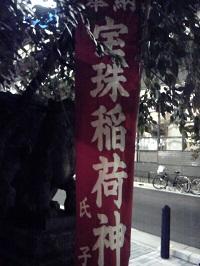
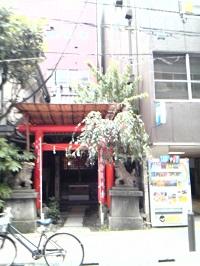
It is located in the valley of the building near Hodo Inari Ginza 4-chome.
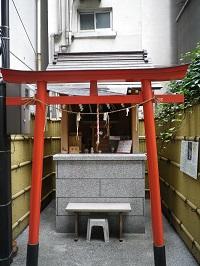
7-chome Toyoiwa Inari Ginza, difficult to find
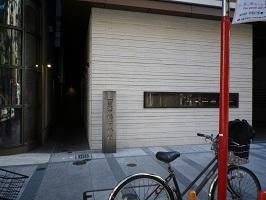 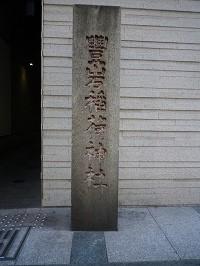
Venus Inari Nihonbashikoamicho

Tokufune Inari Minami Takahashiwaki
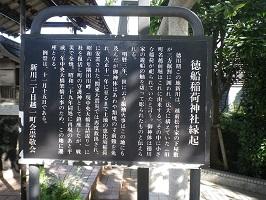
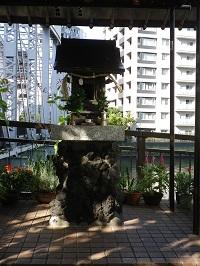
Takao Inari Nihonbashihakozakicho. It seems that there is a connection to the prostitute of the Edo period, Dayu Takao.
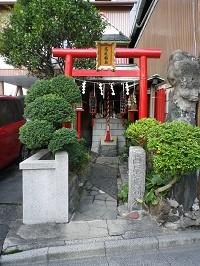
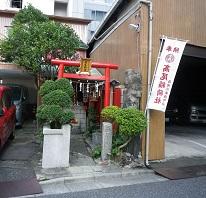
This is Edo's specialty.
[Dharma]
October 16, 2016 18:00
Get off at Hamacho Station on the Shinjuku Line, stop A2, walk along Kiyosumi-dori from Meijiza, turn left at the Hisamatsucho intersection toward Ningyocho. One of the Nihonbashi Seven Lucky Gods, Kotobuki Oigami Shrine. From here, turn right at the Hisamatsu Police Station and you will find "1 sho mochi poster" Japanese confectionery "Minosha".
The owner who makes Japanese sweets with the feeling of the season is important, and the seasonal recommendation is "Kurimushiyokan". I had a pancake-like "Dorayaki". In the Edo period, we left Tomizawa Town, which prospered as a used clothes market for Tobizawa, and headed for Ningyocho.
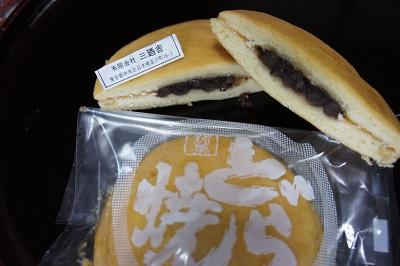 Minoya Minoya
  Turning Ningyocho Station A2 Exit, Ningyocho-dori toward the Horidome intersection, the signboard of "Ubukeya", which sells knives in Ningyocho since the Meiji Restoration, across the road. After that, look at the "Sanko Inari Shrine", turn left and walk a little. Horidome Children's Park. Kiyokazuken, a long-established Japanese confectionery in the foreground. A little earlier, there is "Seisei Inari Shrine", which is said to have been founded in 1617 (1617) in the building valley, and the first generation Danjuro came and gave his name. Turning Ningyocho Station A2 Exit, Ningyocho-dori toward the Horidome intersection, the signboard of "Ubukeya", which sells knives in Ningyocho since the Meiji Restoration, across the road. After that, look at the "Sanko Inari Shrine", turn left and walk a little. Horidome Children's Park. Kiyokazuken, a long-established Japanese confectionery in the foreground. A little earlier, there is "Seisei Inari Shrine", which is said to have been founded in 1617 (1617) in the building valley, and the first generation Danjuro came and gave his name.
Kiyokazuken was founded in 1861 (1864) in Horie-cho, Nihonbashi (currently Kofune-cho). Today's business is a stylish shop on the first floor of a building in Horidome-cho. The 7th-generation shopkeeper has been protecting noren for more than 140 years. The reputation of "Dorayaki" is a fragrant dough and a hearty bean paste, and you can feel the old-fashioned technique and newness. "Kurimanju" is also a good taste.
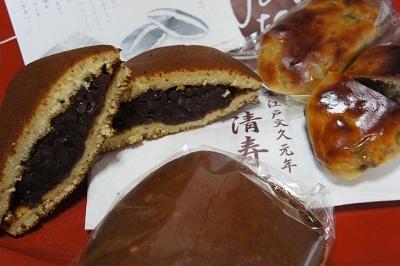 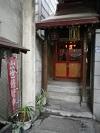 Inari Inari
 I'm going to Kobunacho. Kofune-cho in the Edo period was located between the Horidome River and is said to be one of the leading wholesale districts in Edo. In the Showa period, trading companies, textiles, and pharmaceutical companies entered the market. On this street, which faces the Horidomecho intersection from Showa-dori Honmachi 2-chome intersection, was founded in 1590 (1590), "Ibasen", a fan and fan, "Eel / Takashimaya", founded in 1875 (1875), "Nagase Sangyo", which entered Tokyo in 1911, is a long-established Japanese confectionery "Nitsuki-san". It became a town of Kobuna.......In Horidome-cho, "Sugimori Inari" of Ebisu God, and in Honmachi (formerly Otemmacho), "Ozu Washi" celebrated its 360th anniversary. Nearby is Takarada Ebisu Shrine, a thriving business. I'm going to Kobunacho. Kofune-cho in the Edo period was located between the Horidome River and is said to be one of the leading wholesale districts in Edo. In the Showa period, trading companies, textiles, and pharmaceutical companies entered the market. On this street, which faces the Horidomecho intersection from Showa-dori Honmachi 2-chome intersection, was founded in 1590 (1590), "Ibasen", a fan and fan, "Eel / Takashimaya", founded in 1875 (1875), "Nagase Sangyo", which entered Tokyo in 1911, is a long-established Japanese confectionery "Nitsuki-san". It became a town of Kobuna.......In Horidome-cho, "Sugimori Inari" of Ebisu God, and in Honmachi (formerly Otemmacho), "Ozu Washi" celebrated its 360th anniversary. Nearby is Takarada Ebisu Shrine, a thriving business.
Higetsudo was founded in 1877. Seasonal fresh sweets, red and white bunjo, New Year's kagami mochi, Noshimochi and classic Dorayaki have been loved by local people in the middle of Edo's commercial area....Recently, new flavors of sweets have been created, such as coffee live Daifuku, black madora, and Kurikinton, which were also featured on TV. In Betara City, lucky items Kirisansho and (Kurimiyokan), which are handed down as offerings for Ebisu-ko, are sold at a stall in front of Takarada Ebisu Shrine. The origin of Kirisansho The origin of Kirisansho  Sansho has long been known for its various effects, but since it is spicy, it has been reported that it has been made into a sweet confectionery with new flour to make it easier for children to eat. (Executive Landlord's talk) Sansho has long been known for its various effects, but since it is spicy, it has been reported that it has been made into a sweet confectionery with new flour to make it easier for children to eat. (Executive Landlord's talk)
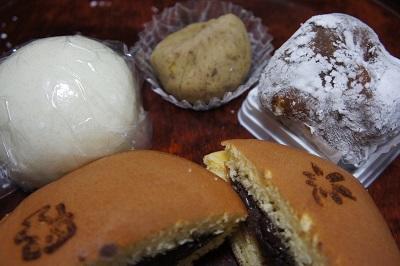 Higetsudo Higetsudo
 October 19th and 20th are the autumn feature "Nihonbashi Ebisu Kobetara City". It is held in the former Otemmacho area (Honmachi 3-chome, Otemmacho, Horidomecho). There are 400 to 500 stalls, mainly at shops that sell Beta pickles, and at night, it is crowded with banquets and open spaces over the years. October 19th and 20th are the autumn feature "Nihonbashi Ebisu Kobetara City". It is held in the former Otemmacho area (Honmachi 3-chome, Otemmacho, Horidomecho). There are 400 to 500 stalls, mainly at shops that sell Beta pickles, and at night, it is crowded with banquets and open spaces over the years.
Above
[Sam]
October 13, 2016 18:00
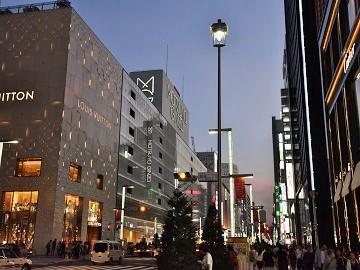 On October 1st, a new commercial facility "Okura House" (Shin-Okura Main Building) opened at the Ginza 2-chome intersection. On October 1st, a new commercial facility "Okura House" (Shin-Okura Main Building) opened at the Ginza 2-chome intersection.
Cartier's flagship store "Cartier Ginza Boutique" opens on the 1st to 3rd basement floors, Japanese cuisine "Ginza Kicho" on the 4th floor, all-day casual dining "bills" on the 12th floor, beauty salons and other clinics and beauty salons on the 5th to 7th floors, and office zones on the 8th to 11st floors.
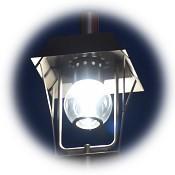 At the same time, the "Ark Light Memorial Light" has been rebuilt and has been lit again since September 26. At the same time, the "Ark Light Memorial Light" has been rebuilt and has been lit again since September 26.
This place is said to have been lit for demonstrations by Kihachiro Okura, one of the founders of Tokyo Lighting Company, using a rice generator in 1882. A place that is said to have been lit for demonstrations.
In 1956, as a commemorative light for "Japan's first electric streetlight place", "Arc Light" was reprinted by the hands of related parties, and a Nishiki-e "Tokyo Ginza Tsutsumi Electric Lighting Lighting" depicting the former situation A bronze plate "Electrical Light Pillar Monument" with the cast of the figure was attached to the side wall.
The light of the arc lamps, which is called 2,000 candlelight, is far brighter than gas lamps and oil lamps, and is parable as "1, Tenmichi-sama, 2nd Moon, and 3rd Arc lamps in Ginza". It is reported that many visitors came to the crowd.
It was rebuilt as the second generation in 1972 and the third generation in 1986, and was once removed in 2012 after Great East Japan Earthquake.
The fourth-generation monument has the same design as at the time of installation. At a height of about 12m, I heard that the former mercury lamp was changed to LED, and the firehouse made of glass was changed to resin.
|
Links
|
 It's the zodiac bell of next year!
It's the zodiac bell of next year! This is also cute.
This is also cute. On October 1st, a new commercial facility "Okura House" (Shin-Okura Main Building) opened at the Ginza 2-chome intersection.
On October 1st, a new commercial facility "Okura House" (Shin-Okura Main Building) opened at the Ginza 2-chome intersection. At the same time, the "Ark Light Memorial Light" has been rebuilt and has been lit again since September 26.
At the same time, the "Ark Light Memorial Light" has been rebuilt and has been lit again since September 26.
